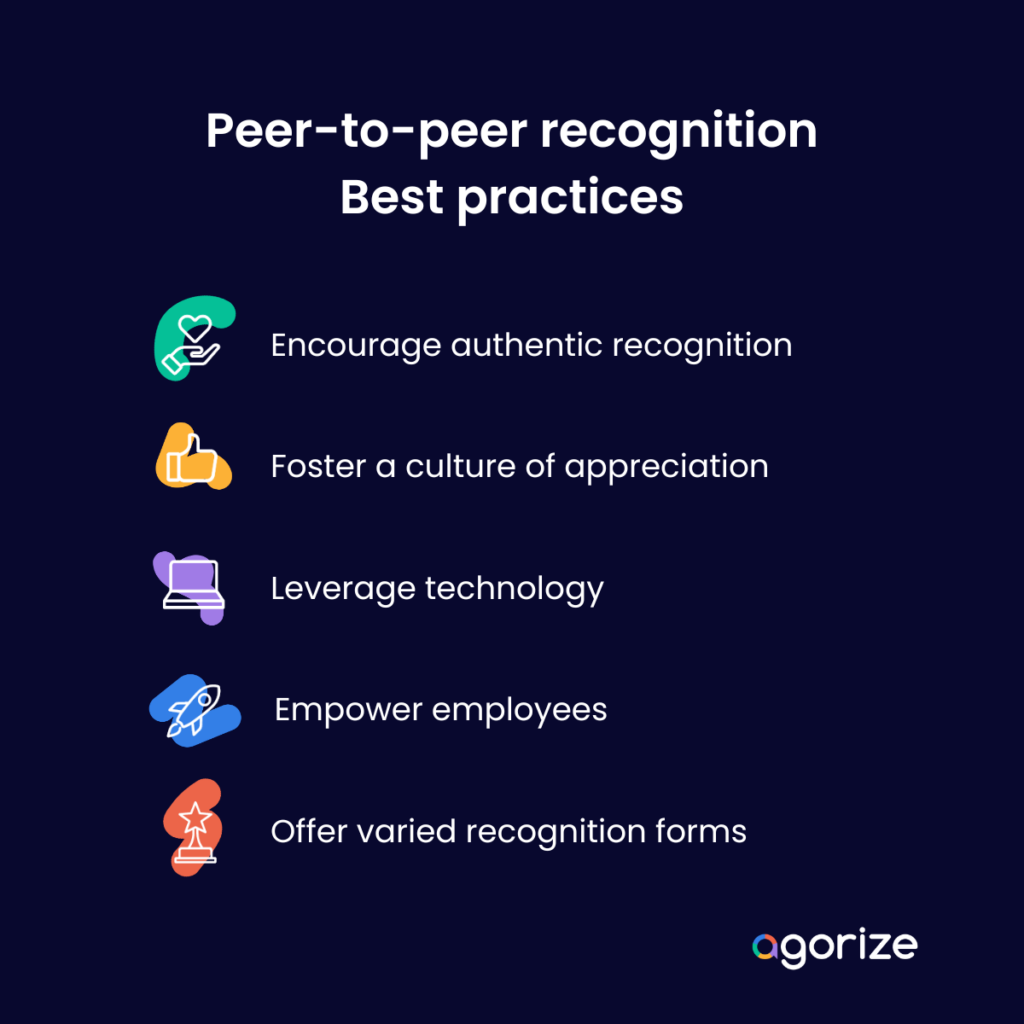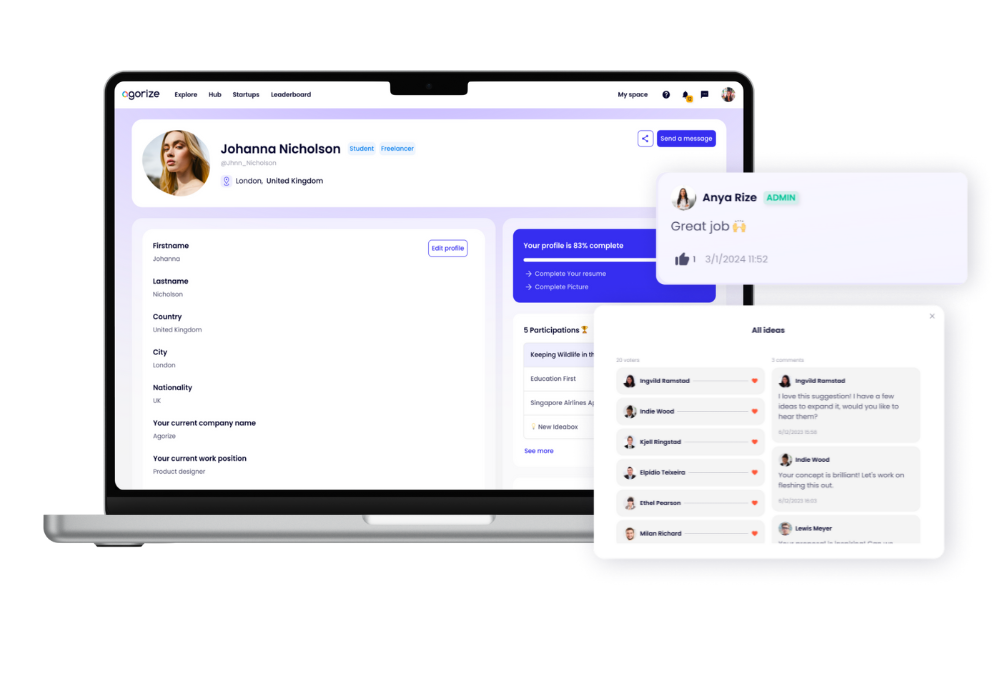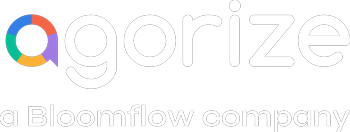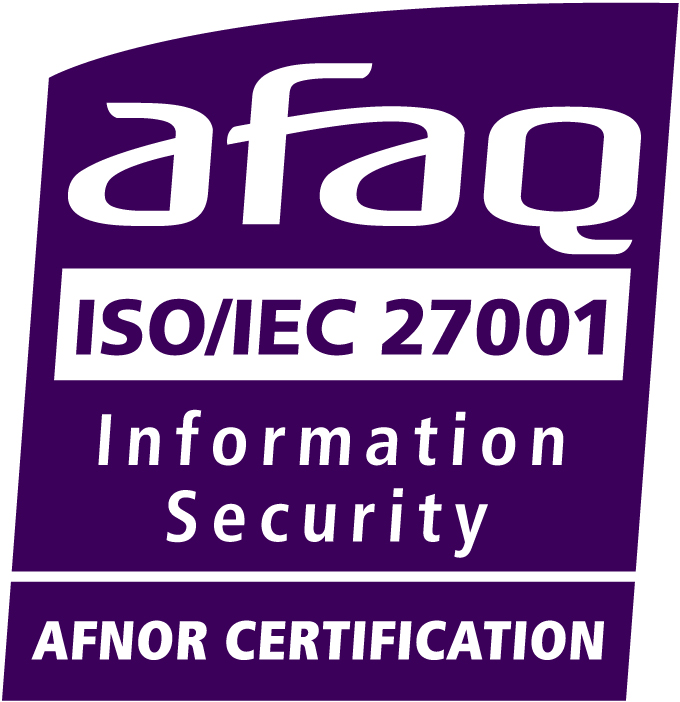In the ever-evolving workplace, peer-to-peer recognition can be a transformative force. When done right, it helps shape a company culture of appreciation and collaboration. To make peer-to-peer recognition a continuous and value-creating effort, global brands like PepsiCo are now organizing dedicated programs around it. It’s an effective method to ensure that feedback is given and received throughout the organization, highlighting the talent and effort of those who deserve such acknowledgment. In this article, we explore the how-to, best practices, and benefits of peer-to-peer recognition programs, and showcase how to easily launch a program for your company.
What is peer-to-peer recognition?
Peer-to-peer recognition is a dynamic employee recognition approach that goes beyond traditional hierarchies. It emphasizes the mutual acknowledgment of contributions among colleagues. Rooted in creating a culture of appreciation and innovation within the workplace, this approach encourages employees to authentically recognize each other’s efforts. As a result, it boosts morale and promotes a collaborative atmosphere. Unlike conventional, top-down employee recognition methods, peer-to-peer recognition places the power of acknowledgment directly in the hands of team members. It fosters a sense of empowerment and engagement throughout the organization. This strategic initiative catalyzes cultivating a positive workplace culture, where innovative ideas and achievements are celebrated, contributing to the overall success and vibrancy of the organizational ecosystem.
Best practices for peer-to-peer recognition
A successful peer-to-peer program can take different shapes, but must always adhere to certain best practices for ideal outcomes.
1. Encourage authentic recognition
Encourage employees to share a genuine appreciation for their colleagues’ efforts. Focus on specific achievements or contributions that have made a meaningful impact on their work or the organization. Remind your teams to focus on authenticity and specificity, as it will be better understood, repeated, and appreciated by the receiver of the feedback and their colleagues.
2. Foster a culture of appreciation
Integrate recognition into the company’s daily routine. Make it a standard practice rather than a sporadic event, to ensure it becomes part of the company values. This constant flow of positive feedback strengthens team bonds and enhances employee engagement. As described in the “Global Human Capital Trends” report, Deloitte found that peer-to-peer recognition boosts overall employee involvement by an average of 20%.
3. Leverage technology
Exchanging feedback at scale can result in frustrating processes and feedback getting lost in a sea of employees’ contributions. Use idea management platforms like Agorize to streamline the recognition process. These platforms provide a centralized space for employees to publicly acknowledge their peers, enhancing visibility and reinforcing a culture of appreciation.
4. Empower employees
Give employees autonomy in recognizing their peers. Go from top-down recognition to encouraging a bottom-up approach to appreciation. This empowerment can lead to a more engaged and motivated workforce.
5. Offer varied recognition forms
While verbal appreciation is valuable, augmenting it with tangible rewards or opportunities for professional growth can significantly enhance the positive impact of employee recognition programs.
In short, keep it quick and easy to do. Public recognition should be accessible to everyone working at the office or remotely, and perhaps to resellers too.

The inspirational how-to of peer-to-peer recognition programs
The power of peer-to-peer recognition programs
Peer-to-peer recognition programs are built on the premise that everyone, regardless of their position, has the potential to contribute ideas and innovations that propel the company forward. A study from Boston Consulting Group found that teams with a strong peer recognition culture generate 1.5 times more innovative ideas. By enabling employees to recognize each other’s contributions, organizations can unlock a treasure trove of innovative ideas and solutions that might otherwise remain hidden. These programs not only spotlight individual achievements but also foster a collaborative environment where sharing success becomes the norm, leading to collective growth and innovation.
Starting a peer-to-peer recognition program is straightforward: provide your team with a platform that facilitates mutual appreciation. Picture yourself as a relaxed observer, akin to a P.E. teacher overseeing a self-managed game, while your team actively engages in acknowledging each other’s efforts.
Initiating a seamless peer recognition program
Embarking on creating a peer recognition program can seem daunting at first, but here are essential steps to guide you:
- Streamline the process: The ideal recognition system should be user-friendly and efficient, catering to busy employees and HR professionals alike.
- Incorporate platforms: Utilizing technology, such as platforms or recognition software, simplifies participation for everyone. It will lower the barrier for people to give recognition.
- Visibility of recognitions: Amplify excitement by displaying recognitions publicly. Integrations with tools such as Microsoft Teams and Outlook, Google Workspace, Slack, or showcasing on a social feed or even on a communal TV, enhance the visibility of appreciation, encouraging a culture of acknowledgment.
- Lead by example: Leadership’s active participation in recognition sets a positive precedent. When managers and executives regularly acknowledge contributions, it not only demonstrates the process but also significantly boosts employee engagement.
By following these steps and looking to successful implementations, you can effectively foster a culture of appreciation and engagement within your organization.
Key benefits of peer-to-peer recognition managed on idea management software
Reinventing talent management with a culture of recognition
Our customers, major international groups, have opted for recognition models to give new impetus to their talent management policies, by putting them at the forefront.
While it doesn’t replace recognition by management or company awards, this approach ensures that everyone has a voice in a secure space. The benefits are experienced by both the employee receiving acknowledgment and the person initiating the process. This fosters commitment without the need to search for the right wording for hours.
Agorize’s comprehensive features: A catalyst for employee recognition and innovation
Agorize’s idea management software is an exemplary platform for hosting peer-to-peer recognition programs. Its comprehensive features foster engagement, innovation, and collaboration. The platform boasts various capabilities. These include customized ideation processes, gamification to engage employees, and full integration with existing tools. These features create an ideal environment for recognizing and developing peer recognition in the workplace.
Here’s what our customers particularly appreciate:
- Centralized social recognition and idea sharing: Agorize provides a single platform where employees can both recognize their peers and share innovative ideas, streamlining the process and enhancing visibility across the organization.
- Engagement through gamification: The platform’s gamification features, like virtual cash investments in top ideas and leaderboards, make recognition fun and encourage continuous participation and idea generation.
- Seamless integration with existing systems: Agorize’s ability to integrate with existing tools ensures that recognizing peer contributions and managing ideas becomes a part of the workflow, rather than an isolated activity.
Implementing peer-to-peer recognition programs on a platform like Agorize not only streamlines the process but also significantly enhances its impact. It helps build a culture of innovation and collaboration to drive organizational growth. Through such platforms, companies can effectively celebrate achievements, share best practices, and collaboratively work towards continuous improvement and innovation.

Measuring the success of your peer-to-peer recognition program
In today’s dynamic work environment, the implementation of peer recognition programs is increasingly becoming a cornerstone for fostering a positive workplace culture and making employees feel appreciated. However, launching such a program is only the first step. The real challenge—and opportunity—lies in effectively measuring its success. This section delves into the best practices for evaluating the impact of your peer recognition initiatives, ensuring they contribute positively to employee engagement, satisfaction, and overall organizational performance.
Measuring the success of a peer recognition program is not just about tracking metrics but understanding its broader impact on your organization’s culture and employees’ well-being. Setting clear KPIs is essential. Utilizing a mix of quantitative and qualitative data and being willing to adapt the program based on feedback ensures that your peer recognition initiative becomes a lasting pillar of your organizational culture, not just a fleeting trend.

Key performance indicators (KPIs) for peer recognition programs
1. Engagement rates
One of the primary indicators of a successful program is active participation. Track the frequency of recognitions given and received across the organization. High engagement rates often correlate with a strong culture of appreciation.
2. Employee satisfaction and morale
Utilize surveys and feedback tools to gauge employee sentiment before and after the implementation of the recognition program. An increase in employee satisfaction and morale is a clear sign of success. The “2021 Global Talent Trends” report finds that peer recognition positively correlates with a 25% increase in employees reporting high levels of well-being.
3. Retention rates
Employee retention is directly impacted by workplace satisfaction. According to research from McKinsey, organizations with a robust peer recognition program in place experience a 30% higher retention rate compared to those without. Monitor changes in turnover rates after the introduction of peer recognition to gain insights into its effectiveness in improving employee loyalty.
4. Productivity metrics
Although more challenging to measure directly, improvements in productivity can often be attributed to enhanced motivation and engagement resulting from recognition programs. Look for trends in output, quality of work, and achievement of individual or team goals. Peer-to-peer recognition contributes to a 15% boost in individual and team productivity according to PwC’s “Future of Work” report.
5. Impact on company culture
Assess how well the program is integrated into the daily routines and overall culture of the organization. This can be evaluated through employee feedback, participation in culture surveys, and observations of workplace interactions. Accenture’s “Getting to Equal” report finds that companies fostering a culture of peer recognition are 2.5 times more likely to have a highly inclusive culture.
Strategies for measuring the success of your peer-to-peer recognition program
There are various ways to ensure that your program is creating meaningful recognition that pays off.
1. Implement regular surveys
Regularly surveying employees can provide direct feedback on the perceived value and impact of the peer recognition program. Questions should aim to understand employees’ feelings of appreciation, motivation, and connection to their peers and the organization.
2. Leverage data analytics
Many modern recognition platforms offer analytics features that can track participation rates, frequency of recognition, and other engagement metrics. This data is invaluable for understanding program utilization and identifying areas for improvement.
3. Conduct qualitative assessments
Besides quantitative data, qualitative insights obtained through focus groups, interviews, and open-ended survey responses can reveal the program’s impact on employee morale, culture, and overall job satisfaction.
4. Compare pre- and post-implementation metrics
Evaluating changes in key metrics before and after the program’s launch can offer a clear picture of its effectiveness. Consider metrics such as employee turnover rates, engagement scores, and productivity levels.
5. Monitor progress over time
Success may not be immediate. It’s important to monitor the program’s impact over an extended period to capture its long-term effects on the organization’s culture and performance.
Peer-to-peer recognition: The foundation of your glass house
Involving your employees in the transformation of your business starts with empowering them and equipping them with the tools they need to drive change.
With the right platform, you can get your peer recognition program up and running quickly. This process of regular recognition needs to be based on these three foundations:
- Encourage continuous participation: Regular reminders, incentives, and recognition of active participants can help maintain high engagement levels.
- Iterate based on feedback: Use the insights gained from measuring your program’s success to make iterative improvements. This could involve adjusting recognition criteria, enhancing rewards, or simplifying the recognition process.
- Integrate recognition into company culture: The success of your peer recognition program depends on whether it becomes a natural part of your organizational culture, where giving and receiving praise becomes a daily practice.
With recognition and rewards, you will be able to accelerate your transformation and foster a culture of innovation through appreciation and collective design.
It will make your employees ambassadors for your brand, which takes care of them and ensures their recognition throughout the year, until your next company awards ceremony.
FAQ
Peer-to-peer recognition is a dynamic employee recognition approach that goes beyond traditional hierarchies. It emphasizes the mutual acknowledgment of contributions among colleagues. Rooted in creating a culture of appreciation and innovation within the workplace, this approach encourages employees to authentically recognize each other’s efforts. As a result, it boosts morale and promotes a collaborative atmosphere.
Embarking on creating a peer recognition program can seem daunting at first, but here are essential steps to guide you:
Streamline the process: The ideal recognition system should be user-friendly and efficient, catering to busy employees and HR professionals alike.
Incorporate platforms: Utilizing technology, such as platforms or recognition software, simplifies participation for everyone. It will lower the barrier for people to give recognition.
Visibility of recognitions: Amplify excitement by displaying recognitions publicly. Integrations with tools such as Microsoft Teams and Outlook, Google Workspace, Slack, or showcasing on a social feed or even on a communal TV, enhance the visibility of appreciation, encouraging a culture of acknowledgment.
Lead by example: Leadership’s active participation in recognition sets a positive precedent. When managers and executives regularly acknowledge contributions, it not only demonstrates the process but also significantly boosts employee engagement.










